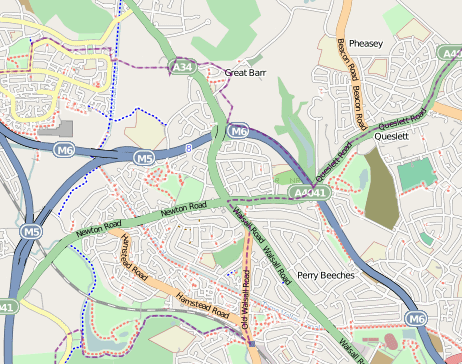B43 Postcode
Postal services were first defined in England by the 1710 Act for establishing a General Post-Office for all Her Majesties Dominions. It has been stated that British houses started being numbered after the Stamp Act of 1765, although this act was mainly concerned with taxing mail from the colonies to raise revenue. The first recorded house number was in 1708 and by the end of the century numbering was well established.
It seems formal requirments for numbering came in The Towns Improvement Clauses Act of 1847 which stated
"The commissioners shall from time to time cause the houses and buildings in all or any of the streets to be marked with numbers as they think fit, and shall cause to be put up or painted on a conspicuous part of some house, building, or place, at or near each end, corner, or entrance of every such street, the name by which such street is to be known".
In many areas houses remain named but un-numbered. In Great Barr many houses on victorian maps were only known by their name.
In January 1932 the Postmaster General approved the division of a nuwmber of large tons into numbered districts and In November 1934 the Post Office announced the introduction of the districts in "every provincial town in the United Kingdom large enough to justify it".
Pamphlets were issued to each householder and business in Birmingham notifying them of the number of the district in which their premises lay. The pamphlets also included a map of the divisions, and copies were made available at local head post offices.
The public were "particularly invited" to include the district number in the address at the head of all private or business letters and a publicity campaign in the following year was made to encourage the use of the district numbers. The slogan for the campaign was "For speed and certainty always use a postal district number on your letters and notepaper".
A poster was fixed to every pillar box in the affected areas bearing the number of the district and appealing for the public's co-operation. Every post office in the numbered district was also to display this information. Businesses were issued with a free booklet containing maps and listings of the correct district number for every street in the area
Each was divided into numbered postal districts. Some Birmingham codes were sub-divided, with a letter, such as Great Barr, Birmingham 22 or Birmingham 22a – as can still be seen on many older street-name signs.
The postal codes used in the United Kingdom ( known as postcodes) are alphanumeric and were introduced by the Royal Mail over a 15-year period from 11 October 1959 to 1974.The earlier district codes were incorporated into the national postcode system. However B22 is not used as a postcode, the area being split into B42 and B43.
Postcodes are alphanumeric and between five and eight characters long (including a single space separating the outward and inward parts of the code).Great Barr having B43 as the outward part and the inward parts being 5 (Hamstead) or 6 (Grove Vale/Whitecrest) or 7 (Wilderness Lane, Chapel Lane, Park Farm and Pheasey areas). 6 and 7 being divide by the M6.
The area bounded by Queslett Road and Walsall Road comes under B42.
References: Wikipedia en.wikipedia.org/wiki/B_postcode_area
The British Postal Museum and Archive
www.doogal.co.uk/UKPostcodes.php



